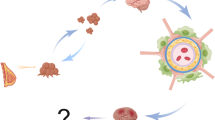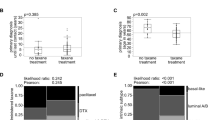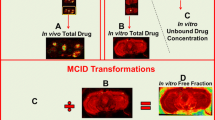Abstract
The blood–brain barrier (BBB) is compromised in brain metastases, allowing for enhanced drug permeation into brain. The extent and heterogeneity of BBB permeability in metastatic lesions is important when considering the administration of chemotherapeutics. Since permeability characteristics have been described in limited experimental models of brain metastases, we sought to define these changes in five brain-tropic breast cancer cell lines: MDA-MB-231BR (triple negative), MDA-MB-231BR-HER2, JIMT-1-BR3, 4T1-BR5 (murine), and SUM190 (inflammatory HER2 expressing). Permeability was assessed using quantitative autoradiography and fluorescence microscopy by co-administration of the tracers 14C-aminoisobutyric acid (AIB) and Texas red conjugated dextran prior to euthanasia. Each experimental brain metastases model produced variably increased permeability to both tracers; additionally, the magnitude of heterogeneity was different among each model with the highest ranges observed in the SUM190 (up to 45-fold increase in AIB) and MDA-MB-231BR-HER2 (up to 33-fold in AIB) models while the lowest range was observed in the JIMT-1-BR3 (up to 5.5-fold in AIB) model. There was no strong correlation observed between lesion size and permeability in any of these preclinical models of brain metastases. Interestingly, the experimental models resulting in smaller mean metastases size resulted in shorter median survival while models producing larger lesions had longer median survival. These findings strengthen the evidence of heterogeneity in brain metastases of breast cancer by utilizing five unique experimental models and simultaneously emphasize the challenges of chemotherapeutic approaches to treat brain metastases.






Similar content being viewed by others
Abbreviations
- BBB:
-
Blood–brain barrier
- BTB:
-
Blood–tumor barrier
- AIB:
-
Aminoisobutyric acid
- TRD:
-
Texas red dextran
- CNS:
-
Central nervous system
- TEER:
-
Transendothelial electrical resistance
- MRI:
-
Magnetic resonance imaging
- VEGF:
-
Vascular endothelial growth factor
- eNOS:
-
Endothelial nitric oxide synthase
- TGFß:
-
Transforming growth factor beta
References
Palmieri D, Smith QR, Lockman PR, Bronder J, Gril B, Chambers AF, Weil RJ, Steeg PS (2006) Brain metastases of breast cancer. Breast Dis 26:139–147
Lin NU, Amiri-Kordestani L, Palmieri D, Liewehr DJ, Steeg PS (2013) CNS metastases in breast cancer: old challenge, new frontiers. Clin Cancer Res 19(23):6404–6418. doi:10.1158/1078-0432.CCR-13-0790
Pardridge WM (2012) Drug transport across the blood–brain barrier. J Cereb Blood Flow Metab 32(11):1959–1972. doi:10.1038/jcbfm.2012.126
Abbott NJ, Patabendige AA, Dolman DE, Yusof SR, Begley DJ (2010) Structure and function of the blood–brain barrier. Neurobiol Dis 37(1):13–25. doi:10.1016/j.nbd.2009.07.030
Hawkins BT, Davis TP (2005) The blood–brain barrier/neurovascular unit in health and disease. Pharmacol Rev 57(2):173–185. doi:10.1124/pr.57.2.4
Abbott NJ (2013) Blood–brain barrier structure and function and the challenges for CNS drug delivery. J Inherit Metab Dis. doi:10.1007/s10545-013-9608-0
Engelhardt B, Liebner S (2014) Novel insights into the development and maintenance of the blood–brain barrier. Cell Tissue Res 355(3):687–699. doi:10.1007/s00441-014-1811-2
Luissint AC, Artus C, Glacial F, Ganeshamoorthy K, Couraud PO (2012) Tight junctions at the blood brain barrier: physiological architecture and disease-associated dysregulation. Fluids Barriers CNS 9(1):23. doi:10.1186/2045-8118-9-23
Butt AM, Jones HC, Abbott NJ (1990) Electrical resistance across the blood–brain barrier in anaesthetized rats: a developmental study. J Physiol 429:47–62
Santaguida S, Janigro D, Hossain M, Oby E, Rapp E, Cucullo L (2006) Side by side comparison between dynamic versus static models of blood–brain barrier in vitro: a permeability study. Brain Res 1109(1):1–13. doi:10.1016/j.brainres.2006.06.027
Abbott NJ, Khan EU, Rollinson CM, Reichel A, Janigro D, Dombrowski SM, Dobbie, Begley DJ (2002) Drug resistance in epilepsy: the role of the blood–brain barrier. Novartis Found Symp 243:38–47 (discussion 47–53, 180–185)
Geldenhuys WJ, Mohammad AS, Adkins CE, Lockman PR (2015) Molecular determinants of blood–brain barrier permeation. Ther Deliv 6(8):961–971. doi:10.4155/tde.15.32
Sa-Pereira I, Brites D, Brito MA (2012) Neurovascular unit: a focus on pericytes. Mol Neurobiol 45(2):327–347. doi:10.1007/s12035-012-8244-2
Dutheil F, Jacob A, Dauchy S, Beaune P, Scherrmann JM, Decleves X, Loriot MA (2010) ABC transporters and cytochromes P450 in the human central nervous system: influence on brain pharmacokinetics and contribution to neurodegenerative disorders. Expert Opin Drug Metab Toxicol 6(10):1161–1174. doi:10.1517/17425255.2010.510832
Meyer J, Rauh J, Galla HJ (1991) The susceptibility of cerebral endothelial cells to astroglial induction of blood–brain barrier enzymes depends on their proliferative state. J Neurochem 57(6):1971–1977
Groothuis DR (2000) The blood–brain and blood–tumor barriers: a review of strategies for increasing drug delivery. Neuro Oncol 2(1):45–59
Levin VA (1980) Relationship of octanol/water partition coefficient and molecular weight to rat brain capillary permeability. J Med Chem 23(6):682–684
Banks WA (2009) Characteristics of compounds that cross the blood–brain barrier. BMC Neurol 9(Suppl 1):S3. doi:10.1186/1471-2377-9-S1-S3
Percy DB, Ribot EJ, Chen Y, McFadden C, Simedrea C, Steeg PS, Chambers AF, Foster PJ (2011) In vivo characterization of changing blood–tumor barrier permeability in a mouse model of breast cancer metastasis: a complementary magnetic resonance imaging approach. Invest Radiol 46(11):718–725. doi:10.1097/RLI.0b013e318226c427
Price JE, Zhang RD (1990) Studies of human breast cancer metastasis using nude mice. Cancer Metastasis Rev 8(4):285–297
Raza A, Franklin MJ, Dudek AZ (2010) Pericytes and vessel maturation during tumor angiogenesis and metastasis. Am J Hematol 85(8):593–598. doi:10.1002/ajh.21745
Fidler IJ, Balasubramanian K, Lin Q, Kim SW, Kim SJ (2010) The brain microenvironment and cancer metastasis. Mol Cells 30(2):93–98. doi:10.1007/s10059-010-0133-9
Dubois LG, Campanati L, Righy C, D’Andrea-Meira I, Spohr TC, Porto-Carreiro I, Pereira CM, Balca-Silva J, Kahn SA, DosSantos MF, Oliveira Mde A, Ximenes-da-Silva A, Lopes MC, Faveret E, Gasparetto EL, Moura-Neto V (2014) Gliomas and the vascular fragility of the blood brain barrier. Front Cell Neurosci 8:418. doi:10.3389/fncel.2014.00418
Shibata S (1989) Ultrastructure of capillary walls in human brain tumors. Acta Neuropathol 78(6):561–571
Hirano A, Matsui T (1975) Vascular structures in brain tumors. Hum Pathol 6(5):611–621
Davies DC (2002) Blood–brain barrier breakdown in septic encephalopathy and brain tumours. J Anat 200(6):639–646
Papadopoulos MC, Saadoun S, Binder DK, Manley GT, Krishna S, Verkman AS (2004) Molecular mechanisms of brain tumor edema. Neuroscience 129(4):1011–1020. doi:10.1016/j.neuroscience.2004.05.044
Gerstner ER, Fine RL (2007) Increased permeability of the blood–brain barrier to chemotherapy in metastatic brain tumors: establishing a treatment paradigm. J Clin Oncol 25(16):2306–2312. doi:10.1200/JCO.2006.10.0677
Hiesiger EM, Voorhies RM, Basler GA, Lipschutz LE, Posner JB, Shapiro WR (1986) Opening the blood–brain and blood–tumor barriers in experimental rat brain tumors: the effect of intracarotid hyperosmolar mannitol on capillary permeability and blood flow. Ann Neurol 19(1):50–59. doi:10.1002/ana.410190110
Runge VM, Clanton JA, Price AC, Wehr CJ, Herzer WA, Partain CL, James AE Jr (1985) The use of Gd DTPA as a perfusion agent and marker of blood–brain barrier disruption. Magn Reson Imaging 3(1):43–55
Lockman PR, Mittapalli RK, Taskar KS, Rudraraju V, Gril B, Bohn KA, Adkins CE, Roberts A, Thorsheim HR, Gaasch JA, Huang S, Palmieri D, Steeg PS, Smith QR (2010) Heterogeneous blood–tumor barrier permeability determines drug efficacy in experimental brain metastases of breast cancer. Clin Cancer Res 16(23):5664–5678. doi:10.1158/1078-0432.CCR-10-1564
Taskar KS, Rudraraju V, Mittapalli RK, Samala R, Thorsheim HR, Lockman J, Gril B, Hua E, Palmieri D, Polli JW, Castellino S, Rubin SD, Lockman PR, Steeg PS, Smith QR (2012) Lapatinib distribution in HER2 overexpressing experimental brain metastases of breast cancer. Pharm Res 29(3):770–781. doi:10.1007/s11095-011-0601-8
Palmieri D, Bronder JL, Herring JM, Yoneda T, Weil RJ, Stark AM, Kurek R, Vega-Valle E, Feigenbaum L, Halverson D, Vortmeyer AO, Steinberg SM, Aldape K, Steeg PS (2007) Her-2 overexpression increases the metastatic outgrowth of breast cancer cells in the brain. Cancer Res 67(9):4190–4198. doi:10.1158/0008-5472.CAN-06-3316
Tanner M, Kapanen AI, Junttila T, Raheem O, Grenman S, Elo J, Elenius K, Isola J (2004) Characterization of a novel cell line established from a patient with herceptin-resistant breast cancer. Mol Cancer Ther 3(12):1585–1592
Tao K, Fang M, Alroy J, Sahagian GG (2008) Imagable 4T1 model for the study of late stage breast cancer. BMC Cancer 8:228. doi:10.1186/1471-2407-8-228
Heppner GH, Miller FR, Shekhar PM (2000) Nontransgenic models of breast cancer. Breast Cancer Res BCR 2(5):331–334
Cailleau R, Young R, Olive M, Reeves WJ Jr (1974) Breast tumor cell lines from pleural effusions. J Natl Cancer Inst 53(3):661–674
Guise TA, Yin JJ, Taylor SD, Kumagai Y, Dallas M, Boyce BF, Yoneda T, Mundy GR (1996) Evidence for a causal role of parathyroid hormone-related protein in the pathogenesis of human breast cancer-mediated osteolysis. J Clin Investig 98(7):1544–1549. doi:10.1172/JCI118947
Grigoriadis A, Mackay A, Noel E, Wu PJ, Natrajan R, Frankum J, Reis-Filho JS, Tutt A (2012) Molecular characterisation of cell line models for triple-negative breast cancers. BMC Genom 13:619. doi:10.1186/1471-2164-13-619
Fernandez SV, Robertson FM, Pei J, Aburto-Chumpitaz L, Mu Z, Chu K, Alpaugh RK, Huang Y, Cao Y, Ye Z, Cai KQ, Boley KM, Klein-Szanto AJ, Devarajan K, Addya S, Cristofanilli M (2013) Inflammatory breast cancer (IBC): clues for targeted therapies. Breast Cancer Res Treat 140(1):23–33. doi:10.1007/s10549-013-2600-4
Ono Y, Abe K, Hayashi M, Chernov MF, Okada Y, Sakai S, Takakura K (2013) Optimal visualization of multiple brain metastases for gamma knife radiosurgery. Acta Neurochir Suppl 116:159–166. doi:10.1007/978-3-7091-1376-9_25
Bruzzone MG, D’Incerti L, Farina LL, Cuccarini V, Finocchiaro G (2012) CT and MRI of brain tumors. Q J Nucl Med Mol Imaging 56(2):112–137
Price SJ (2010) Advances in imaging low-grade gliomas. Adv Tech Stand Neurosurg 35:1–34
Perilongo G, Garre ML, Giangaspero F (2003) Low-grade gliomas and leptomeningeal dissemination: a poorly understood phenomenon. child’s nervous system. ChNS Off J Int Soc Pediatr Neurosurg 19(4):197–203. doi:10.1007/s00381-003-0733-1
Lee EK, Lee EJ, Kim MS, Park HJ, Park NH, Park S 2nd, Lee YS (2012) Intracranial metastases: spectrum of MR imaging findings. Acta Radiol 53(10):1173–1185. doi:10.1258/ar.2012.120291
Murrell DH, Hamilton AM, Mallett CL, van Gorkum R, Chambers AF, Foster PJ (2015) Understanding heterogeneity and permeability of brain metastases in murine models of HER2-positive breast cancer through magnetic resonance imaging: implications for detection and therapy. Transl Oncol 8(3):176–184. doi:10.1016/j.tranon.2015.03.009
Perera M, Ribot EJ, Percy DB, McFadden C, Simedrea C, Palmieri D, Chambers AF, Foster PJ (2012) In vivo magnetic resonance imaging for investigating the development and distribution of experimental brain metastases due to breast cancer. Transl Oncol 5(3):217–225
Murrell DH, Foster PJ, Chambers AF (2013) Brain metastases from breast cancer: lessons from experimental magnetic resonance imaging studies and clinical implications. J Mol Med. doi:10.1007/s00109-013-1108-z
Heyn C, Ronald JA, Ramadan SS, Snir JA, Barry AM, MacKenzie LT, Mikulis DJ, Palmieri D, Bronder JL, Steeg PS, Yoneda T, MacDonald IC, Chambers AF, Rutt BK, Foster PJ (2006) In vivo MRI of cancer cell fate at the single-cell level in a mouse model of breast cancer metastasis to the brain. Magn Reson Med 56(5):1001–1010. doi:10.1002/mrm.21029
Greig NH, Genka S, Daly EM, Sweeney DJ, Rapoport SI (1990) Physicochemical and pharmacokinetic parameters of seven lipophilic chlorambucil esters designed for brain penetration. Cancer Chemother Pharmacol 25(5):311–319
Adkins CE, Nounou MI, Hye T, Mohammad AS, Terrell-Hall T, Mohan NK, Eldon MA, Hoch U, Lockman PR (2015) NKTR-102 efficacy versus irinotecan in a mouse model of brain metastases of breast cancer. BMC Cancer 15:685. doi:10.1186/s12885-015-1672-4
Nduom EK, Yang C, Merrill MJ, Zhuang Z, Lonser RR (2013) Characterization of the blood–brain barrier of metastatic and primary malignant neoplasms. J Neurosurg. doi:10.3171/2013.3.JNS122226
Bulnes S, Argandona EG, Bengoetxea H, Leis O, Ortuzar N, Lafuente JV (2010) The role of eNOS in vascular permeability in ENU-induced gliomas. Acta Neurochir Suppl 106:277–282. doi:10.1007/978-3-211-98811-4_52
Chaitanya GV, Cromer WE, Wells SR, Jennings MH, Couraud PO, Romero IA, Weksler B, Erdreich-Epstein A, Mathis JM, Minagar A, Alexander JS (2011) Gliovascular and cytokine interactions modulate brain endothelial barrier in vitro. J Neuroinflamm 8:162. doi:10.1186/1742-2094-8-162
Argyriou AA, Giannopoulou E, Kalofonos HP (2009) Angiogenesis and anti-angiogenic molecularly targeted therapies in malignant gliomas. Oncology 77(1):1–11. doi:10.1159/000218165
Castejon OJ (2012) Ultrastructural pathology of endothelial tight junctions in human brain oedema. Folia Neuropathol 50(2):118–129
Acknowledgments
This research was supported by Grants from the National Cancer Institute (R01CA166067-01A1) and National Institute of General Medical Sciences (P30GM103488, and GM103434). Additional support for this research was provided by WVCTSI through the National Institute of General Medical Sciences of the National Institutes of Health under Award Number U54GM104942. A portion of this work was completed at each institution mentioned in the author affiliations.
Author information
Authors and Affiliations
Corresponding author
Rights and permissions
About this article
Cite this article
Adkins, C.E., Mohammad, A.S., Terrell-Hall, T.B. et al. Characterization of passive permeability at the blood–tumor barrier in five preclinical models of brain metastases of breast cancer. Clin Exp Metastasis 33, 373–383 (2016). https://doi.org/10.1007/s10585-016-9784-z
Received:
Accepted:
Published:
Issue Date:
DOI: https://doi.org/10.1007/s10585-016-9784-z




